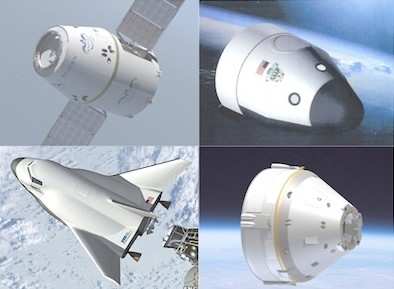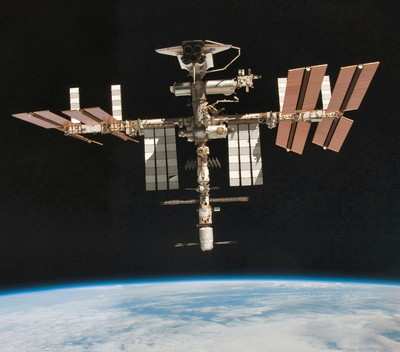Digging Trenches And Making Tar Pits
Commentary/Analysis By ANN Space Analyst, Wes Oleszewski
On January 18, 2006 NASA announced the COTS program. COTS stands
for Commercial Orbital Transportation Services and is rooted in the
concept that private companies can provide a means of supplying
cargo and later crews to the International Space Station (ISS) in
light of NASA’s thinning budget. It is also thought that the
COTS program will, according the then NASA Administrator Michael
Griffin, “…be a huge opportunity for truly commercial
space enterprise.” and COTS would thus “…engage
the engine of competition,” so that “these services
will be provided in a more cost-effective fashion than when the
government has to do it. “ All that was required in order to
make the dream come true was a little bit of Federal money to prime
that “engine of competition.”

Funding of $175,000,000 was allotted
for the winners of the initial COTS contracts. Seven months after
the initial COTS rollout the contract winners, Rocketplane Kistler
and SpaceX were announced. Rocketplane Kistler was later
disqualified on February 19, 2008 and Orbital Sciences Corporation
took their place in the COTS second round selection. Running in
tandem with the Constellation moon program, it appeared then as if
the COTS program would compliment NASA’s Federal space
efforts nicely. There were, however, a few flaws in the plan.
Flaw number one came when the Federal Government handed out that
175 million dollars. No “private” company can remain
private once it hooks up to the I.V. that drips tax dollars- not
that there is anything wrong with that. There are plenty of Federal
contractors who do great work and spaceflight of any sort is hugely
expensive. Today, both SpaceX and Orbital are doing fantastic
things and the US taxpayers are getting tremendous mileage for
their dollars. The rub comes with those folks in the spaceflight
and political circles who argue for a “pure commercial”
space program… supported by more and more Federal dollars.
Chief among these folks is President Obama who has gone to the
greatest lengths to make this Federally subsidized, pure commercial
paradox come true. The simple fact is, the more Federal dollars a
company takes, the less private they must become. This all turns
into a dollars vs. the dreams tar pit. Each Federal dollar has a
string attached and soon trying operate a program as efficiently as
a private corporation turns into trying to sprint in a tar pit of
Federal regulations and oversight.

The next flaw was created when the President used his office to
try and force his pure commercial paradox on the entire United
States space effort by canceling the Constellation program and
leaving nothing but the COTS contractors to fill the void when the
Space Shuttle was retired. This radical and myopic move resulted in
a backlash from the Congress as well as most of the spaceflight
community. The Congress quickly reaffirmed, by law, that it is the
policy of the United States to have Federally operated human space
exploration program and hardware. In turn that caused the President
to push farther his pure commercial paradox when on April 15th,
2010 he visited KSC and Cape Canaveral making a first-hand visit to
the space X facilities while essentially ignoring NASA's
spaceport.
Soon some unexpected human factors came into play as the
spaceflight community began to entrench on two very different
sides; “commercial” and “Federal.” A
needless trench-war developed that, given the current condition of
the US manned space program, will be of no good to either side.

With the United States having retired the Space Shuttle with no
replacement being in work, what is needed is not either
“commercial” or “Federal,” but BOTH. NASA,
needs the wizardry of the folks at SpaceX right now as much as the
American people need NASA. The same goes for Orbital and likewise
we need the companies that are not a part of COTS. A good look at
history will teach us this lesson in spaceflight success. A good
example being the Saturn I, Block II vehicles first stages- SA-5,
6, 7 and 9 were officially built by NASA at MSFC while SA-8 and
SA-10 were built by the Chrysler Corporation as were all of the
S-IB stages. Yet, no one thought of those Chrysler boosters as
being “commercial,” or “private.” Likewise,
numerous Apollo era companies put their own cash into products that
were later contracted to NASA. Additionally, in Project Gemini the
booster was built by the Martin Corporation and the spacecraft was
built by the McDonnell Company under contract to NASA. If the same
“Pure Commercial” paradox had been inserted at any
point in that effort we would never have gotten to the moon.
Unfortunately, there are those who are making political hay from
the commercial vs. Federal trench war. A case in point being
California Representative Dana Rohrabacher who continues to press
to have NASA's Space Launch System (SLS) canceled in order to leave
only “commercial” to fill the void. Yet at the
same time he sits in committee and whines about how two entrenched
sides have formed on the issue. Each time he speaks on the subject
he does little more than make the trenches deeper and the tar pit
wider. The American people are simply lucky that when Rohrabacher
begins to bloviate he is normally the only dissenting voice on the
committee pulling to cancel the Federal program.

Still, like Rohrabacher, there are some in the spaceflight
community who chant the “Commercial good- Federal bad”
mantra. This, in the belief that all Federal space dollars should
go to “commercial” spaceflight- which would thus, no
longer make them commercial. Along the way other companies that
have a spaceflight heritage, such as Boeing, Lockheed Martin and
especially ATK are vilified as being the spawn of satin. The whole
thing begins to become as silly looking as Occupy Wall Street
although it may not smell as bad. In fact the heritage companies
are simply Federal contractors and nothing more. Likewise SpaceX
and Orbital are not the spaceflight messiah. They are simply new
and different and… Like it or not, since they are now taking
federal dollars under the COTS program, they too are now Federal
contractors.
Under study, this whole commercial vs. Federal argument appears
to be dividing the spaceflight community at a critical point in its
history. A time when, more so than at any point in past four
decades, the community needs to function together as a team. And it
calls into question, was that division the intention of the
President in the first place?
 ANN's Daily Aero-Term (05.12.25): Execute Missed Approach
ANN's Daily Aero-Term (05.12.25): Execute Missed Approach ANN's Daily Aero-Linx (05.12.25)
ANN's Daily Aero-Linx (05.12.25) NTSB Final Report: Piper PA-36-375
NTSB Final Report: Piper PA-36-375 Airborne-NextGen 05.06.25: AF Uncrewed Fighters, Drones v Planes, Joby Crew Test
Airborne-NextGen 05.06.25: AF Uncrewed Fighters, Drones v Planes, Joby Crew Test ANN's Daily Aero-Linx (05.13.25)
ANN's Daily Aero-Linx (05.13.25)






